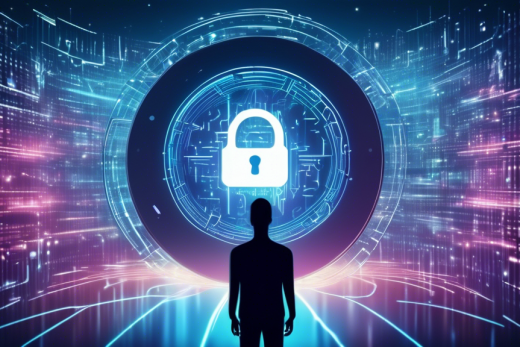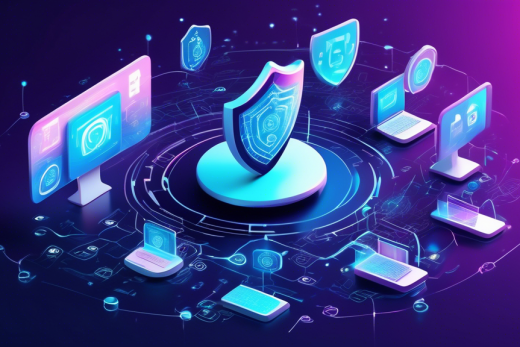Essential Tips for Enhancing Your Online Privacy and Security
In today’s digital age, protecting your online privacy and security is more crucial than ever. As we increasingly rely on the internet for everything from banking to social networking, the potential threats to our personal information have grown exponentially. Understanding and implementing the right strategies can safeguard you from cybercriminals and ensure your private information stays confidential.
This comprehensive guide is designed to help you enhance your online privacy and security, covering a range of actionable tips and best practices. By the end of this article, you’ll be equipped with the knowledge and tools necessary to defend against digital threats and maintain your online privacy with confidence.
Strengthen Your Passwords and Use Two-Factor Authentication
Overview of the Importance of Strong, Unique Passwords
In today’s digital age, strengthening your online privacy and security starts with the basics: passwords. Having strong, unique passwords for each of your online accounts is critical. Weak or reused passwords can easily be cracked or hacked, potentially giving cybercriminals access to sensitive personal information.
Tips for Creating Complex Passwords
Creating complex passwords doesn’t have to be difficult. Here are some key tips to consider:
- Length: Aim for at least 12 characters.
- Variety: Use a mix of uppercase and lowercase letters, numbers, and special symbols.
- Avoid common words: Refrain from using obvious choices like “password” or “123456”.
- Randomization: Create passwords that don’t follow easily guessable patterns.
For example, instead of using a password like “JohnDoe1990!”, you might opt for something more randomized like “X9j!2@7DfM$%”. This added complexity greatly enhances your online privacy and security.
How to Effectively Use a Password Manager
Managing multiple strong, unique passwords can be overwhelming. This is where password managers come in. A password manager securely stores all your passwords in an encrypted format, requiring you to remember only a single master password. Some notable password managers include LastPass, Dashlane, and 1Password.
Here’s how to use a password manager effectively:
- Install a reputable password manager: Choose one with a strong reputation and good reviews.
- Create a strong master password: Ensure this password is also strong and unique, as it will be the key to all your other passwords.
- Store your passwords: Input all your existing passwords into the manager and generate new, strong passwords for each of your accounts.
- Enable autofill: Most password managers offer an autofill feature, simplifying the process of logging into your accounts while ensuring your passwords remain secure.
Explanation of Two-Factor Authentication (2FA) and Its Benefits
Two-factor authentication (2FA) adds an additional layer of security to your online accounts. It requires not only a password and username but also something that only the user has on them, such as a physical token, a mobile phone, or some form of biometric verification.
The benefits of 2FA include:
- Enhanced security: It significantly reduces the risk of unauthorized access, even if your password is compromised.
- Easy implementation: Most major platforms offer 2FA options, making it easy to set up.
- Peace of mind: Knowing that your data is protected by two layers of security can give you greater confidence in your online interactions.
Steps to Enable 2FA on Popular Platforms
Enabling 2FA varies depending on the platform, but here are some general steps and examples:
- Go to your Google Account at myaccount.google.com.
- In the “Security” section, select “2-Step Verification”.
- Click “Get Started” and follow the on-screen instructions.
- Choose the 2FA method you prefer, such as text message or Google Authenticator.
- Go to the “Settings & Privacy” section from the drop-down menu in the top right corner.
- Click “Security and Login” and then “Use two-factor authentication”.
- Choose your security method (e.g., text message) and follow the instructions.
Apple ID
- Sign in to your Apple ID account page at appleid.apple.com.
- In the “Security” section, click “Edit”.
- Click “Turn on two-factor authentication” and follow the on-screen instructions.
By following these steps and making use of both strong passwords and two-factor authentication, you can significantly enhance your online privacy and security, making it much harder for cyber threats to compromise your personal information.
Secure Your Internet Connection and Personal Devices
The Role of a Secure Internet Connection in Online Privacy and Security
Securing your internet connection is fundamental to safeguarding your online privacy and security. An unsecured connection can expose your personal information to hackers and cyber threats. Ensuring your network is protected can prevent unauthorized access, keeping your data and communications safe.
Guide to Setting Up a Secure Home Wi-Fi Network
Creating a secure home Wi-Fi network is easier than you might think. Start by changing the default SSID (network name) and password provided by your router manufacturer. Using a strong, unique password for your network can significantly reduce the risk of unauthorized access. Additionally, it’s crucial to enable WPA3 encryption if your router supports it; otherwise, use WPA2.
Regularly updating your router’s firmware is another essential step. Firmware updates often include security patches that address vulnerabilities. Access your router settings via its IP address, usually found on the router itself or in the user manual, to check for updates. Lastly, disable remote management features unless you absolutely need them, as these can provide additional vectors for attacks.
Importance of Using a Virtual Private Network (VPN) and Recommendations
Using a Virtual Private Network (VPN) is a powerful tool in protecting your online privacy and security. A VPN encrypts your internet traffic, masking your IP address and making it difficult for potential intruders to track your online activities. This is particularly important when using public Wi-Fi networks, which are notoriously insecure.
There are many VPN services available, but it’s essential to choose one with strong encryption standards, a no-logs policy, and reliable performance. Some trusted options include NordVPN, ExpressVPN, and CyberGhost. While free VPNs exist, they often come with limitations and may sometimes compromise your security, so investing in a reputable service is advisable.
Best Practices for Maintaining Device Security
Keeping your devices secure is a key aspect of maintaining online privacy and security. Ensure all your software, including operating systems and applications, is up-to-date. Updates frequently include security fixes that protect against the latest threats. For mobile devices, consider enabling automatic updates to ensure you don’t miss critical patches.
Installing antivirus and anti-malware software provides an additional layer of protection. These tools can detect and eliminate threats before they cause significant damage. Some top-rated options include Norton, McAfee, and Bitdefender. Additionally, avoid downloading apps from untrusted sources, as these can often carry malware.
Protecting Your Devices in Public Places
Public places are rife with potential security risks, from unsecured Wi-Fi networks to physical theft. When using public Wi-Fi, always connect through a VPN to encrypt your internet traffic. Avoid accessing sensitive information, such as banking or personal accounts, on public networks whenever possible.
Physically securing your devices is equally important. Never leave your devices unattended, and consider using a physical lock for laptops if you need to leave them momentarily. Using a privacy screen can also prevent shoulder surfing, where someone may look over your shoulder to steal sensitive information.
By following these recommendations, you can significantly enhance your online privacy and security, protecting your data from a range of cyber threats. Regularly updating your knowledge and adapting to new security practices will ensure you stay one step ahead in the ever-evolving landscape of digital security.
Be Cautious with Your Online Activities and Data Sharing
In the modern digital era, our online activities and the data we share have a substantial impact on our online privacy and security. Understanding the risks associated with oversharing and being vigilant about the information we divulge can go a long way in safeguarding our personal data. Here, we’ll delve into various strategies to help you stay cautious and secure in your online activities.
Understanding the Risks of Oversharing Personal Information Online
One of the most significant threats to online privacy and security is the unintended oversharing of personal information. Social media platforms and other online services often request extensive personal details that, if shared publicly or fall into the wrong hands, can lead to identity theft or other cyber crimes.
To mitigate these risks:
- Limit Personal Information: Only share essential information required for a service and avoid posting sensitive details like your home address, phone number, or financial information on public forums.
- Review Your Profile: Regularly review your social media profiles to ensure you are not inadvertently sharing more than necessary.
- Think Before You Post: Be mindful about the photos and updates you share. Consider who can view them and how they might interpret the information.
Recognizing and Avoiding Phishing Scams and Malicious Links
Phishing scams are deceptive attempts to procure sensitive information such as usernames, passwords, or financial details by pretending to be a trustworthy entity in electronic communications. Malicious links embedded in emails, messages, or websites pose another significant cyber threat.
To protect yourself:
- Verify the Source: Be cautious of unsolicited communications that ask for personal information. Verify the source by checking the sender’s details or contacting the company directly.
- Inspect Links and Attachments: Hover over links to preview the URL before clicking. Avoid downloading attachments from unexpected or dubious emails.
- Use Spam Filters: Employ email providers and cybersecurity tools that offer spam filtering and protection against phishing attempts.
Understanding these scams and employing the necessary precautions can greatly enhance your online privacy and security.
Tips for Managing Privacy Settings on Social Media and Other Platforms
Social media platforms offer various privacy settings that allow users to control the visibility of their information. Managing these settings effectively is crucial for maintaining online privacy and security.
Consider the following tips:
- Regularly Update Privacy Settings: Familiarize yourself with the privacy controls of each platform you use and adjust settings to suit your preferences. This includes who can see your posts, send you friend requests, or follow your account.
- Review Third-Party App Access: Monitor the apps and websites connected to your social media accounts. Revoke access for those you no longer use or trust.
- Enable Activity Alerts: Use features that notify you of suspicious login attempts or changes to your account’s activity.
These practices ensure that only trusted individuals have access to your information, thereby bolstering your online privacy and security.
Importance of Regular Monitoring for Suspicious Activity
Proactively monitoring your online accounts can help detect unauthorized access or other suspicious activities early. This vigilance is key to maintaining online privacy and security.
Here’s how you can stay alert:
- Check Account Activity Logs: Regularly review the activity logs of your online accounts to spot any unusual or unauthorized actions.
- Set Up Alerts: Most financial institutions and online services offer notifications for account activities. Enable these alerts to be immediately informed of any changes or transactions.
- Review Financial Statements: Frequently review your bank and credit card statements to identify and report any unauthorized charges promptly.
Maintaining an active watch over your accounts not only protects your online identity but also helps in promptly addressing potential security breaches.
Best Practices for Safely Using Cloud Services and Sharing Files
Cloud services offer convenient storage and sharing solutions, but they also come with risks if not used cautiously. Ensuring the security of your data on cloud platforms is vital for online privacy and security.
Follow these best practices:
- Use Strong Passwords and 2FA: Secure your cloud accounts with robust passwords and enable two-factor authentication to add an extra layer of security.
- Encrypt Sensitive Data: Encrypt files before uploading them to cloud services to protect your data from unauthorized access.
- Share with Caution: Only share files with trusted individuals and use password protection and view-only permissions where applicable.
By adopting these measures, you can securely leverage the benefits of cloud services while protecting your personal information.
In conclusion, being cautious with your online activities and data sharing is critical for enhancing your online privacy and security. By understanding the risks, recognizing phishing scams, managing privacy settings, monitoring for suspicious activity, and following best practices for cloud usage, you can significantly safeguard your personal data in the digital realm.
Conclusion
Enhancing your online privacy and security is more critical than ever in today’s interconnected world. From the very basics of strengthening your passwords and employing two-factor authentication to the advanced steps of securing your internet connection with a VPN and maintaining vigilant control over your online activities, these measures collectively offer a robust defense against a myriad of online threats.
By implementing these essential tips, you can significantly reduce the risks to your personal data and online accounts. Remember that online privacy and security is an ongoing process that requires regular updates and attentiveness. Stay informed about the latest threats and advancements in technology to ensure that your defenses remain strong and effective. Your proactive efforts today in safeguarding your digital life will pay off in the long run by providing you with a safer and more secure online experience.



